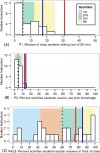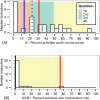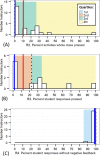PORTAAL: A Classroom Observation Tool Assessing Evidence-Based Teaching Practices for Active Learning in Large Science, Technology, Engineering, and Mathematics Classes
- PMID: 26033871
- PMCID: PMC4477739
- DOI: 10.1187/cbe.14-06-0095
PORTAAL: A Classroom Observation Tool Assessing Evidence-Based Teaching Practices for Active Learning in Large Science, Technology, Engineering, and Mathematics Classes
Abstract
There is extensive evidence that active learning works better than a completely passive lecture. Despite this evidence, adoption of these evidence-based teaching practices remains low. In this paper, we offer one tool to help faculty members implement active learning. This tool identifies 21 readily implemented elements that have been shown to increase student outcomes related to achievement, logic development, or other relevant learning goals with college-age students. Thus, this tool both clarifies the research-supported elements of best practices for instructor implementation of active learning in the classroom setting and measures instructors' alignment with these practices. We describe how we reviewed the discipline-based education research literature to identify best practices in active learning for adult learners in the classroom and used these results to develop an observation tool (Practical Observation Rubric To Assess Active Learning, or PORTAAL) that documents the extent to which instructors incorporate these practices into their classrooms. We then use PORTAAL to explore the classroom practices of 25 introductory biology instructors who employ some form of active learning. Overall, PORTAAL documents how well aligned classrooms are with research-supported best practices for active learning and provides specific feedback and guidance to instructors to allow them to identify what they do well and what could be improved.
© 2015 S. L. Eddy et al. CBE—Life Sciences Education © 2015 The American Society for Cell Biology. This article is distributed by The American Society for Cell Biology under license from the author(s). It is available to the public under an Attribution–Noncommercial–Share Alike 3.0 Unported Creative Commons License (http://creativecommons.org/licenses/by-nc-sa/3.0).
Figures





Similar articles
-
An exploration of the relationship between active learning and student motivation in STEM: a mixed methods study.Adv Physiol Educ. 2024 Sep 1;48(3):621-638. doi: 10.1152/advan.00247.2022. Epub 2024 Jun 27. Adv Physiol Educ. 2024. PMID: 38932697 Free PMC article.
-
The Classroom Observation Protocol for Undergraduate STEM (COPUS): a new instrument to characterize university STEM classroom practices.CBE Life Sci Educ. 2013 Winter;12(4):618-27. doi: 10.1187/cbe.13-08-0154. CBE Life Sci Educ. 2013. PMID: 24297289 Free PMC article.
-
A Multi-Institutional Analysis of Instructional Beliefs and Practices in Gateway Courses to the Sciences.CBE Life Sci Educ. 2019 Jun;18(2):ar26. doi: 10.1187/cbe.17-12-0257. CBE Life Sci Educ. 2019. PMID: 31144569 Free PMC article.
-
On faculty development of STEM inclusive teaching practices.FEMS Microbiol Lett. 2017 Oct 2;364(18). doi: 10.1093/femsle/fnx179. FEMS Microbiol Lett. 2017. PMID: 28922842 Review.
-
Research-based implementation of peer instruction: a literature review.CBE Life Sci Educ. 2015 Mar 2;14(1):es3. doi: 10.1187/cbe.14-11-0198. CBE Life Sci Educ. 2015. PMID: 25713095 Free PMC article. Review.
Cited by
-
The role of a team psychological safety feeling in teamwork in the classroom.Heliyon. 2024 Sep 7;10(18):e37618. doi: 10.1016/j.heliyon.2024.e37618. eCollection 2024 Sep 30. Heliyon. 2024. PMID: 39309768 Free PMC article.
-
Eight Indicators for Measuring Equitable Student Success in STEM.Change. 2024;56(3):4-14. doi: 10.1080/00091383.2024.2348425. Epub 2024 Jun 18. Change. 2024. PMID: 39228657 Free PMC article. No abstract available.
-
An exploration of the relationship between active learning and student motivation in STEM: a mixed methods study.Adv Physiol Educ. 2024 Sep 1;48(3):621-638. doi: 10.1152/advan.00247.2022. Epub 2024 Jun 27. Adv Physiol Educ. 2024. PMID: 38932697 Free PMC article.
-
Assessing Community College Biology Student Perceptions of Being Called on in Class.CBE Life Sci Educ. 2023 Dec;22(4):ar51. doi: 10.1187/cbe.23-05-0068. CBE Life Sci Educ. 2023. PMID: 37906686 Free PMC article.
-
Rethinking Learning Experience: How Generally Perceived Life Stress Influences Students' Course Perceptions in Different Learning Environments.Eur J Investig Health Psychol Educ. 2023 Aug 12;13(8):1491-1504. doi: 10.3390/ejihpe13080109. Eur J Investig Health Psychol Educ. 2023. PMID: 37623306 Free PMC article.
References
-
- Aggarwal P, O’Brien CL. Social loafing on group projects: structural antecedents and effect on student satisfaction. J Market Educ. 2008;30:255–264.
-
- American Association for the Advancement of Science . Describing and Measuring Undergraduate STEM Teaching Practices. Washington, DC: 2013.
-
- Aronson J, Fried CB, Good C. Reducing the effects of stereotype threat on African American college students by shaping theories of intelligence. J Exp Soc Psychol. 2002;38:113–125.
-
- Bell BS, Kozlowski SWJ. Active learning: effects of core training design elements on self-regulatory processes, learning and adaptability. J Appl Psychol. 2008;93:296–316. - PubMed
-
- Borrego M, Cutler S, Prince M, Henderson C, Froyd JE. Fidelity of implementation of research-based instructional strategies in engineering science courses. J Eng Educ. 2013;102:394–425.
Publication types
MeSH terms
LinkOut - more resources
Full Text Sources
Other Literature Sources


